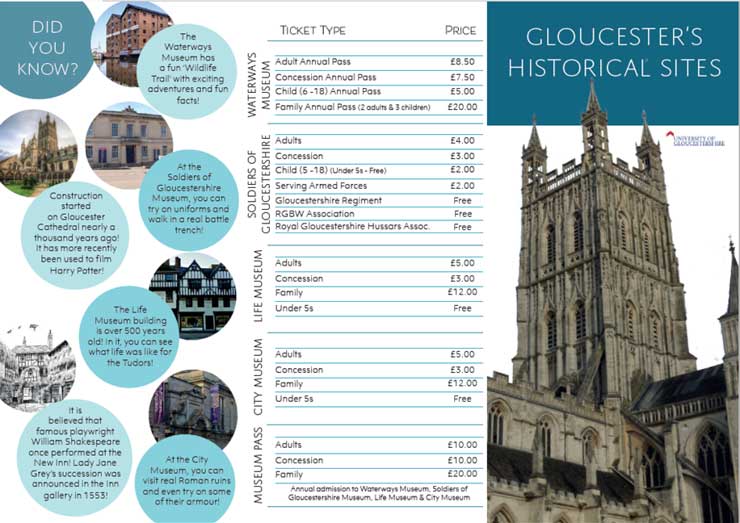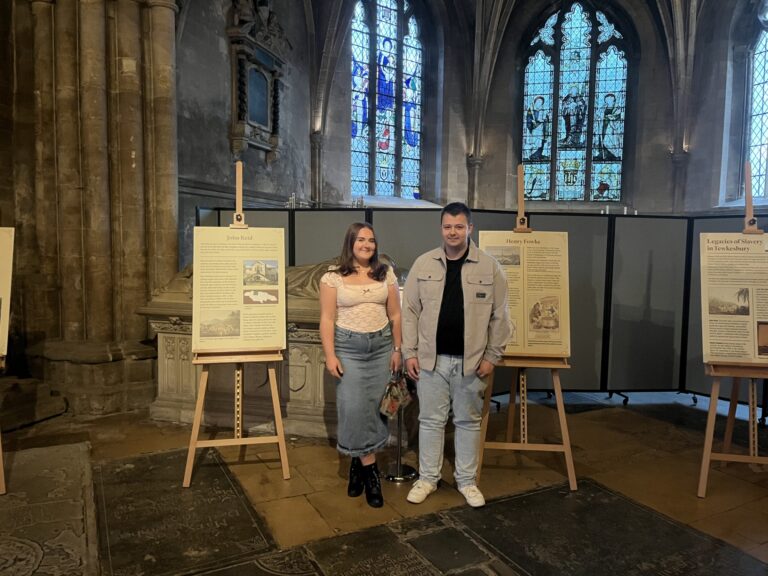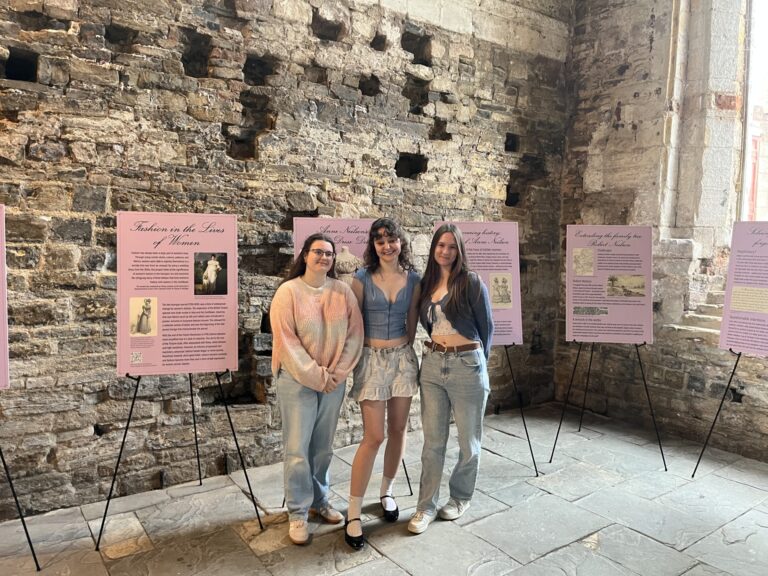| CC4HH
Gloucester’s historical sites
This project was conducted by Rebekah Dinwoodie, Dawn Fullwood, Andrew Jungelson, Amelia Whittle.
Jump to: Introduction | Sites of interest | Mariner’s Chapel | Eastgate viewing platform | The House of the Tailor | New Inn
Introduction
Our group project was tasked with creating a local history walk for visitors to Gloucester. It involved identifying a number of sites of interest and producing a leaflet so tourists and locals alike can find new places and stories that reveal the rich history of the city.
A leaflet has been produced so that tourists and locals can discover new places, in which walking routes have additionally been designed for children to enjoy and understand.
A primary focus has been to create educational and entertaining opportunities for visitors to the city. The leaflet outlines places to visit, including museums, and the architecture and public works of art in the city.
Key information is provided for each of these, including accessibility, admission prices and opening times (correct at going to press in May 2018). We have brought together information on sites we believe would be interesting to visitors, and have removed some from our list due to expensive admissions, or a lack of information.
We visited Gloucester on 23 January 2018 and quickly realised that designating one single walk would not be beneficial, due to the length of the proposed walk as well as time taken to explore each site.
Key sites are identified on a map so visitors can explore them all, should they wish. Visitors can section off the map and spend a day in different parts of the city to experience the historical sites of Gloucester.


Sites of interest
MARINER’S CHAPEL

The Mariner’s Chapel (pictured) is in Gloucester Docks, the most inland port in the country. It had an influence on locals and seafarers alike.
The Chapel was built in 1849 and was designed for the boatmen passing through the River Severn and Gloucester-Sharpness Canal. The Chaplain arranged services in foreign languages due to the range of nationalities on the ships in port.
Between 1849 and 1854, over 14,000 leaflets were distributed by the church, in 12 different languages.
In 1884, a nearby former cheese warehouse was purchased by the church and was used as a meeting hall for reading and writing lessons and also a coffee bar for those wishing to meet with friends.
The organ was as portable as the Chaplain. Yet, services were not restricted to the church. If the weather was decent, the congregation large or a ship not mooring in port for long, then services were held on the quayside or on ships.
The inclusivity, humanity and willingness to adapt to circumstances are what makes this tiny Chapel so important to the history of Gloucester.
Eastgate viewing platform
Explore Gloucester’s Roman heritage!
The glass viewing platform at the end of Eastgate Street allows visitors to look down onto the Roman fortress remains that lie beneath the city. The remains of walls are from a Roman fortress dating to around 68AD. The plaque states the ruins are where the City East Gates stood from the 1st century until the 18th century.
The site also includes the remains of a Tudor ‘horse-pool’, where horses and livestock were washed before going to market.


Tours take visitors below the viewing platform to see the ruins up close. Visitors can physically touch the stones and see the layout of the whole chamber. Tours can be booked at Gloucester Museum.
The chamber is important to Gloucester’s history. It may not be prominent, but it is subtle. History is all over Gloucester, hidden away in the most unsuspecting places, even beneath your own feet.
The House of the Tailor of Gloucester
The House of the Tailor of Gloucester is a charming museum and quaint shop. The building is in College Court which stands on the perimeter of the Cathedral. This was where Beatrix Potter sketched and it inspired her to write her ‘favourite book’. The museum and shop are open to the public from Monday to Saturday 10am to 4.30pm and Sunday noon until 4pm.

The inspiration for her story came in May 1894, when Potter was staying with her cousin Caroline Hutton. Whilst at the Hutton’s home, Caroline told Beatrix the curious tale of a local tailor.
Upon closing his shop at Saturday lunchtime with a waistcoat cut out but not sewn together, he was surprised to discover when he opened the shop on Monday, that apart from one buttonhole, the waistcoat had been sewn together and a tiny note was pinned to the buttonhole which read, “no more twist”.
Beatrix requested a visit to Gloucester. When she saw the tailor’s shop, she sketched some of the buildings. In 1901 the tale was committed to paper as a Christmas present for the daughter of one of her tutors, Freda Moore.
The original building on the site of the House of the Tailor can be traced back to 1535. It was in a lane that originally ran alongside the precinct wall of St Peter’s Abbey – now the Cathedral. In 1953 the ‘House’ became an antique shop, then owned by Mr. Percy Zatman, a dealer in gold and silver. In 1978, the property was purchased by Frederick Warne and Co. Ltd. Using Beatrix Potter’s illustrations in The Tailor of Gloucester, Warne’s remodelled the shop’s interior and frontage.
New Inn
The Grade I listed building, located on Northgate street, dates as far back as the mid-15th century. Despite a modest entrance, it boasts 36 bedrooms.
It was once used to hold the coronation of Lady Jane Grey and is believed to have been where William Shakespeare once performed.
Much of the architecture remains as it was hundreds of years ago, carefully preserved and refurbished.
The New Inn’s courtyard is one of the best preserved medieval courtyards with a gallery in the whole country.
Some have claimed that the Inn is haunted, with multiple paranormal disturbances having been reported. It has even been investigated by the Gloucester Active Paranormal Society!

The New Inn is an important addition to the walk as it helps to show that, in contrast to some perhaps more obvious historical locations, there is another, more humble aspect to Gloucester’s history, and as you take a sip from your drink in the medieval courtyard, you can imagine people doing the same thing 500 years ago!



